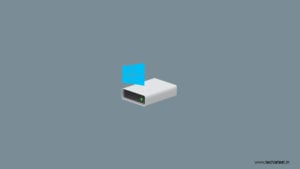
Whenever you try to format your USB drive or any storage drive like an external hard disk or an SSD, you must have seen exFAT, NTFS, FAT32 as file system options. They are different types of file systems and serve different functions.
So what really is the difference between exFAT vs FAT32 vs NTFS? Let’s find out!
In this article, we are going to discuss exFAT vs FAT32 vs NTFS and tell you the actual difference between these file systems.
What is File System?

As mentioned earlier, exFAT, FAT32 and NTFS are three different file systems that are used for formatting storage drives like internal HDD, SSD, SD Card, external HDD, SSD, USB drives, etc. The file system helps in organizing the data stored in a drive.
It is used to specify how data is going to be stored in a drive and it also specifies what type of data can be attached to a file. The data includes file names, attributes, permissions, etc.
Also, Read: How to Partition an External Hard Disk in Windows 10
exFAT vs FAT32 vs NTFS
exFAT vs FAT32 vs NTFS: Basic Differences
| exFAT | FAT32 | NTFS | |
| Origins | Introduced with Windows XP and Vista | First introduced with Windows 95 | Introduced with Windows NT and used a lot after Windows XP |
| Compatibility with Different Operating Systems | Works with all versions of Windows | Works well with all versions of Windows. Compatible with Linux, macOS, etc. | Works with all versions of Windows |
| Readability | To use it, you will need additional software on Linux | Needs no special configuration to use with Mac gadgets | Read-only for Mac and some versions of Linux |
| Maximum File Size and Partition Limits | No file size or partition size limits | Maximum File Size: 4GB Maximum Partition Size: 8GB | No file size or partition size limits |
| Current Status | Improved version of FAT32, and it is supported by more devices and OS compared to NTFS | Older file system and not as efficient as NTFS | Most modern file system.Windows use NTFS system drive and, by default, for most non-removable drives. |
| Best for | Can be used for flash drives | Easy and quick to access format | It gives a lot of features like file permissions, shadows copies for backup, encryption, disk quota limits, etc. |
Now that we have established the basic differences between the three, it is time to understand each of the file systems one by one.
Also, Read: How to Format USB as exFAT?
exFAT

exFAT file system came into origin in 2006. It stands for Extended File Allocation Table. exFAT is the modern version of FAT32. The main aim of this file system is to bring the same lightweight file system as FAT32 and also avoiding the additional features of NTFS.
It is very good for use with flash drives. While there is still not match for exFAT to FAT32 when it comes to compatibility, exFAT still has a giant advantage over NTFS in terms of compatibility.
The NTFS file system is read-only on Mac OS X, exFAT has full read-write support on Macs and exFAT drives become accessible to Linux if you use the correct software.
The good thing about exFAT is that it can be used to store larger files extending the 4GB size limit compared to FAT32. It also does not have any limits on partition sizes.
So you can store files that are larger than 4GB, a feature that FAT32 does not allows.
FAT32
FAT32 file system is the oldest file system of all three. It was first introduced with Windows 95.
In terms of compatibility, FAT32 is the most compatible file system and the reason for that is because it has been around for so long.
It is one of the biggest advantages of FAT32 as it is compatible with anything that has a USB port including Windows, Mac, Linux, gaming consoles, etc.
However it also has some disadvantages, the biggest one being that you can only store an individual file under 4GB on a FAT32 drive. The partition size should also be less than 8TB.
FAT32 is quite old and it is not very ideal for internal drives. Most of the new versions of Windows can’t be installed on a FAT32 drive. They require drives formatted with NTFS as it has more security and permissions features.
NTFS

NTFS is the Windows default file system for everything. When you install Windows 10 on your computer, it automatically formats the drive with the NTFS file system. It has a lot of features that FAT32 and exFAT lacks.
NTFS comes with file permissions for security. It also has a change journal that really comes in handy in recovering errors if your computer crashes.
It has other features too including shadow copies for backups, encryption, disk quota limits, hard links, etc. File permissions are very important for system drives. SO you should always format the system drive with NTFS.
The only disadvantage is that it is not as compatible as other file systems. It works with all versions of Windows but it is read-only for Mac OS X by default.
Some Linux distributions support writing for NTFS drives but most of them are read-only. The Sony PlayStations do not support NTFS, Xbox 360 consoles do not read NTFS drives. Although Xbox One can read NTFS drives.
In a Nutshell

exFAT is the new upgraded file system for FAT32 and NTFS is the modern file system used by Windows as a default file system. For internal drives, the NTFS file system is the best as it has a lot of security and permissions features.
On the other hand, exFAT is great for flash drives as it is very lightweight. For some cases, you might require a FAT32 file system to format an external drive when the device you are going to use it with does not supports exFAT.
Closing Phrase
So that was all about exFAT vs FAT32 vs NTFS. There are advantages and disadvantages for all of these file systems.
exFAT and FAT32 are more compatible with a lot of devices and they are also very lightweight making them ideal to use with flash drives. On the other hand, NTFS has a lot of essential features making it ideal for internal drives.
We hope this article helped you in understanding the differences between exFAT vs FAT32 vs NTFS file systems.
Also, Read: Pros and Cons of Using NTFS Software on Apple’s New Big Sur Update
Directly in Your Inbox



![[5 Fixes] How to Format SD Card for 3DS Easily Nintendo 3DS Family](https://media.tech-latest.com/wp-content/uploads/2023/11/14211239/Nintendo-3DS-Family-1-300x150.jpg)





